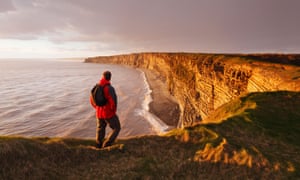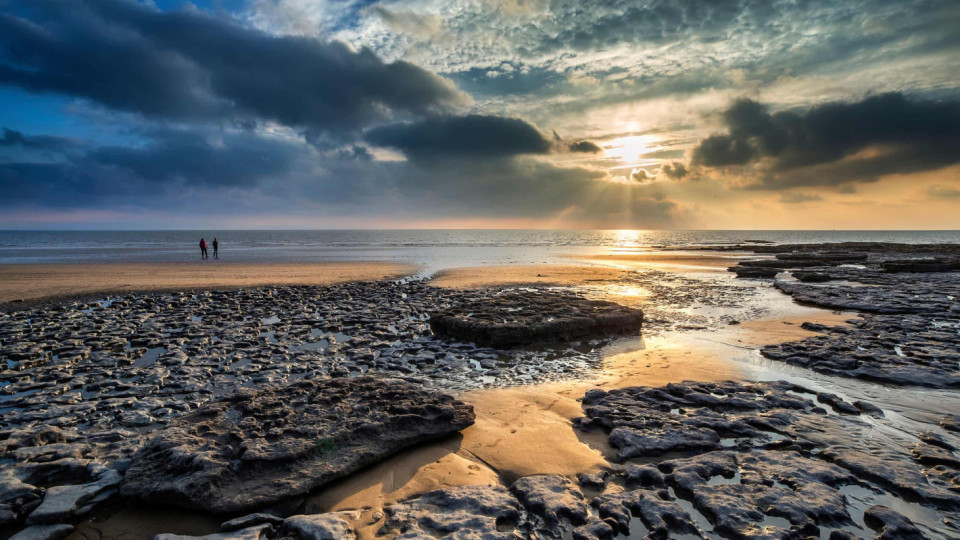
In the first of her monthly car-free coast series, our writer takes the train to the Vale of Glamorgan, to explore its beaches and clifftops by bus and on foot

Clifftop bluebells frame the view. Below us is the beach we’ve just crossed, balancing on barnacle-crusted rocks and jumping over rain-boosted streams. As the falcon flies, we’re less than 20 miles from Cardiff, but there is a wild remoteness here in the cascading valleys, pungent with wild garlic, and shining sand that mirrors a cloudy sky.
I’ve joined the Vale of Glamorgan branch of the Ramblers for a walk along the crumbling shore, after first filling up on gourmet fish and chips in Monknash. Cliffs rise like shale-and-limestone layer cake over curving waves of rock, and a huge fossilised ammonite clings to one stony ledge.

Glamorgan’s 14-mile Heritage Coast, from St Athan to Ogmore-by-Sea, rivals Devon and Dorset’s Jurassic coast for geological marvels. It seems extraordinary it’s not better-known. In 2012, Wales became the first country in the world to create a walking route along the entire length of its coast, 870 miles in total. Ramblers Cymru is holding a festival from 4-19 May to celebrate seven years since the Wales Coast Path opened, with more than 40 walks in seven locations, from Llandudno on the north coast down to Llantwit Major, here in the Vale of Glamorgan.
We’re hiking the short stretch of beach from Cwm Nash to Witches Point, which is only walkable at low tide. The official coast path runs along the top of the cliffs above.
The south Wales coast has some of the biggest tidal extremes in the world and it’s easy to get trapped. Rock falls are a danger too; as I stray towards a waterfall to take a photo, the walk leader waves me away from the cliffs. Climbing safely up again along a path lined with primroses, we stroll through empty walled gardens, ghostly remnants of Dunraven Castle.

Over the next headland, I’m ridiculously excited by the moody sands of Dunraven, which became Bad Wolf Bay in Doctor Who (in the series two finale where Rose and the Doctor say goodbye). A prickly golden bank of gorse nearby smells headily of piña coladas. Peaceful Slade Garden, less than half a mile away, spills down through a wooded glen. Here cockleshell paths wind through tulips and magnolia, while streamside kingcups and delicate fritillaries drip in the misty drizzle (a self-guided tour with farmhouse tea costs £9.50).
A Welsh spring was never going to deliver a sun-lounger-style beach holiday. The evening before, there was a sugar-sprinkle of snow among the baby lambs and frothy blossom in the fields as my train pulled into the small town of Llantwit Major (on a branch line from Cardiff), and a midnight downpour mixed with the distant shushing of surf on shingle. But the cabins at Hide at St Donats, in woodland a mile out of town, have log stoves, woven blankets and hot water bottles. I slept in a treehouse-like bedroom in high-beamed Walden Lodge, named after Henry David Thoreau’s 1854 memoir of “life in the woods”.

Hide is virtually on the coast path, a couple of miles from a lighthouse at Nash Point. An hourly bus (number 303, Mon-Sat) stops nearby on its way from Barry to Bridgend. It visits most of the Heritage Coast beaches and villages, including Ogmore-by-Sea, where the Two Anchors barbecue cafe pops up on the beach in summer, grilling seasonal veg or salmon over the fire. The coast path turns inland here, on the dune and saltmarsh-fringed bank of the Ogmore river. Sudden sunlight warms the sturdy waterside ruins of Ogmore Castle; tawny wallflowers sprout between stones, swans drift past below and pony trekkers ride out of Ogmore Farm riding centre next door along sandy tracks to the sea.
Taking the bus back to Llantwit, I stand near the old stone dovecote, looking over the Bristol Channel towards Exmoor. There’s a numinous sense of pilgrimage among the carved Celtic stones at one end of nearby St Illtud’s church, founded as a college in 500AD. And for real church art fans, St Cadoc’s church in Llancarfan is worth the six-mile hike along a B road.

It depicts two devils encouraging a couple in the sin of lust while another devil pours beer into a red-coated glutton. This is part of a wall painting of the seven sins, issuing from fiery dragon mouths, that were discovered by accident 12 years ago under 20 coats of whitewash. They are “the most important paintings found on a church wall this millennium,” local enthusiast Ian Fell told me.
It feels appropriately gluttonous to spend an evening sampling botanical beers from the Tomos a Lilford microbrewery, which the Llantwit Major- to-Cowbridge bus conveniently passes. I’m quickly befuddled by ales infused with foraged rockweed and with rose petals and cardamom (a local legend about women luring pirates ashore provided inspiration, apparently).
With more time, I’d have downed a couple of pints at Oscar’s in Cowbridge, the Vale of Glamorgan’s other understated town, before collapsing into one of the big beds at the Bear (doubles from £81), an old coaching inn that backs on to the town’s trim box-hedged, rosemary-fragrant Physic Garden. There are lots of buses from Cowbridge to Cardiff, even on Sundays, and from there my train takes just two hours back to London, speeding past woods bright with starry anemones.
The Guardian











Leave a comment